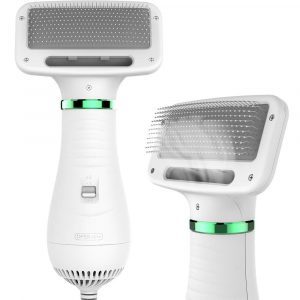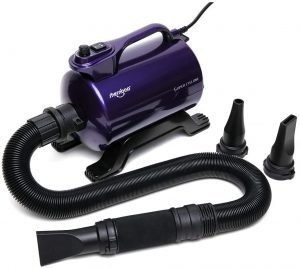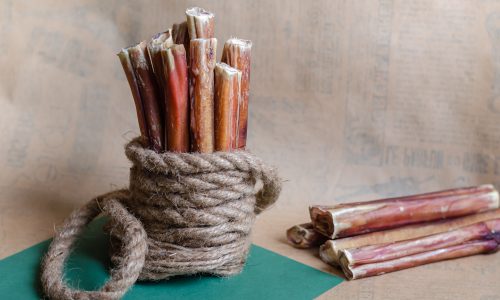The Best Dog Dryer

Our Review Process
Don't Waste Your Money is focused on helping you make the best purchasing decision. Our team of experts spends hundreds of hours analyzing, testing, and researching products so you don't have to. Learn more.
Our Picks For The Top Dog Dryers
- 1. AIIYME Low Noise Professional Dog Dryer
- 2. PETNF Strong Wind Thickened Filter Dog Dryer
- 3. SHELANDY Noise Reduction Dog Dryer
- 4. Shernbao Adjustable Air Speed Dog Dryer
- 5. LIVEKEY Safety Tip Pins Dog Dryer
- 6. iPettie Dual Temperature Dog Dryer
- 7. CHAOLUN Quick Dry Low Noise Dog Dryer
- 8. Flying Pig Grooming Stepless Variable Airflow Dog Dryer
Keep your pup's fur looking its best with this dog dryer. The device is designed for faster drying times, while running much quieter than a typical hair dryer. Included with the dryer are four different nozzle attachments, a grooming brush, a bath glove and a towel.
Multiple Color OptionsYou'll find this dog dryer comes in a choice of blue, black or gray.
Available in black or blue, this dog dryer has an ergonomic handle and anti-skid feet. The hose measures 73 inches, so you can dry your pet from head to toe without having to move the machine. Heat settings are adjustable, and you'll find four different nozzles come with the set.
Easy to OperateThanks to the upgraded design of this dog dryer, your pet's hair will dry much faster.
A fast airflow helps you finalize a pet's grooming quickly. You'll get an adjustable output power and a voltage of 110/120 to provide an airflow of 65 to 135 MPH. The body comes in two different colors, and you'll get four types of nozzles and a flexible hose that can reach as far as 73 inches.
Versatile OptionWith adjustable temperatures and speeds, this dog dryer can be used on a variety of dog and cat sizes.
This dog dryer helps groom while you dry, with wide-apart bristles that can help remove tangles and loose fur with minimal pulling and tugging. You can choose between a high or low temperature, allowing you to customize the heat to your own dog's tolerance levels. Each stainless-steel pin in the brush has safety tips to keep it soft against your pe...
Time SaverBrush while you're drying your pet's hair with this combination hair dryer and brush.
Buying Guide
Baths are an unavoidable part of pet ownership, especially if you have a breed with fur that needs regular grooming. But all that wet fur can take a while to dry on its own, which is why blow-drying is part of any professional groomer’s process.
Even with the right tools, drying a dog can be tricky. You’ll want to make sure the air is warm enough to keep the dog comfortable without applying too much heat. Some pets are afraid of the noise, while others are simply spooked by the air blowing around them.
There are some dog dryers that keep those nuisances to a minimum to make it easier to dry your dog’s hair. As hand dryers for pets have grown in popularity, manufacturers have come up with a variety of ways to improve on the technology. They’ve built in more power with less noise, which means you can dry your pet more quickly while still keeping their discomfort to a minimum. Many also have multiple heat settings to let you keep things cooler if your pet prefers.
It can take some time for pets to get used to the feeling and sound of a new dryer. For best results, introduce the pet gradually to the new appliance, combining it with something like towel-drying and air-drying at first. Once it’s clear your dog is used to the dryer, you can use it until your dog is completely dry.
What to Look For
- Watch your dog carefully while you’re drying to make sure you aren’t causing discomfort. To be safe, start on a lower temperature and move around constantly to avoid applying heat in the same place for too long. Also, make sure you always keep the dryer at least a couple of inches away from your pet’s skin.
- Towel-drying can be a great way to sop up extra water and shorten the drying process. If you use a towel, press it gently against the pet’s skin rather than rubbing it. Rubbing it can cause the fur to mat or tangle, complicating future grooming sessions.
- Brushing is an important part of the grooming process. Use a wide-bristled brush both before and after drying your pet’s hair. If your dog’s hair is tangled, don’t force brushing. Instead, work on brushing your dog’s hair regularly to prevent tangles from happening in the first place.
- The airflow can make a big difference in your dryer’s performance. More air can reduce drying time considerably, but your pet might find the air overwhelming. Look for a dryer with multiple speeds that will let you gradually boost the air.
- The hose length is worth noting. You’ll need a little extra length to ensure you can freely move around your pet while you’re working.
- Many dog dryers come with different nozzles that you can change up. This is especially important if you’ll be using your dryer to groom multiple pets.
- Mobile groomers will need to pay close attention to the portability of any dryer they choose. If it stays on a vehicle, this might not be as important, but grooming in people’s homes or places of business means you’ll need to be able to pack it up and take it with you.
- The handles on some dryers are more comfortable than others. This might not be as important if it only takes a few minutes to dry your dog, but if it takes a while or you have multiple pets, you should pay close attention to the handle design.
More to Explore
Grooming needs vary from one dog breed to another. Some dogs have fur while others have hair, and one requires more maintenance than the other.
Dogs with fur don’t rely on grooming as much as dogs with hair. A dog with fur naturally sheds hair as needed. Those dogs have three growth patterns: growing, resting and shedding. This fur will shed once it reaches a certain length to make way for new growth. These dogs can stand regular washing and brushing, and you won’t see the problems with matting and tangles that you’ll see with dogs that have hair.
On the other hand, dogs with hair need regular grooming. These breeds, which include Yorkshire terriers, Maltese, Shih Tzus and Havanese, don’t see the shedding that dogs with fur have, so you’ll need regular trimming to keep the hair under control.


















